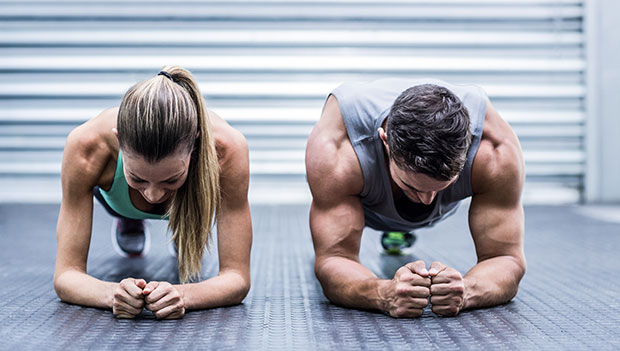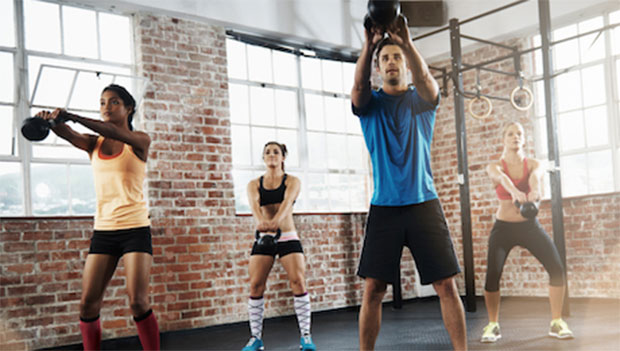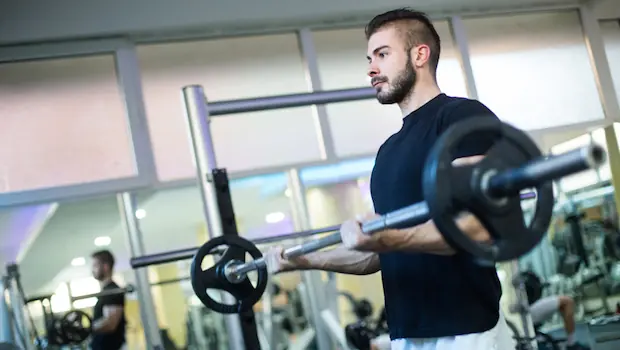
Full-Body Exercises | Full-Body Workouts | Full-Body Dumbbell Workouts | Full-Body Workouts At Home | Bowflex Home Gym | Best Functional Trainers
People work out at home for a variety of reasons. Some find the crowds at the gym annoying or intimidating, or they like the solitude working out at home provides. Others find it difficult to budget time in their day to travel to and from the gym. You've probably noticed that working out at home comes with its advantages and disadvantages—the most obvious being accessibility to equipment.
Whatever your reason, and whatever level of investment you're willing to put into equipment, you can still meet and exceed your fitness goals working out at home. In this article, we'll lay out three full-body workouts you can do at home with no equipment, with limited equipment, or with a fully equipped home gym.
What You'll Need to be Successful Working Out At Home
Let’s set aside equipment for a moment and talk about what you’ll need to be successful working out at home. An intentional plan is crucial to get started. One downside to working out at home is the lack of external pressure and accountability.
What exactly do we mean by this? Most people can convince themselves to roll out of bed and go to the gym if they're spending money on a membership, or if they've signed up for a class to attend. But when you're rolling out of bed to go into the next room, it can be easy to convince yourself to hit snooze instead. If that sounds all too familiar, try downloading a fitness app, or following a preset workout plan until your fitness regimen becomes a consistent routine.
3 Full-Body Workouts You Can Do at Home
Full-Body Bodyweight Workout
No equipment? No problem. You can still get an effective full-body workout by using your bodyweight. According to Harvard Health, studies show that bodyweight training improves aerobic capacity, muscle endurance, and flexibility. In other words, you’ll feel better, become stronger, and have more energy. In our bodyweight workout plan we’ve included exercises that can be adjusted based on your fitness level.
Note: Rest 30-60 seconds between sets.

Push-ups: 3 sets of 10 reps
- How-to: Place your hands on the ground or floor beneath you about shoulder-width apart. Keep your core tight and elbows in at your sides. Lower your chest to the ground and press back up.
- Adjust the difficulty: If you find a standard push-up too easy, try elevating your feet on a box or a chair. If you're having trouble with a standard push-up, start on your knees or with your hands elevated.
Pull-ups: 3 sets of 10 reps
- How-to: Start with an overhand grip on a pull-up bar, slightly wider than shoulder-width. With your arms extended above you, stick your chest out and maintain a slight curve in the back. Keep your legs stable and pull up so your chest is at the same level as the bar. Squeeze your shoulder blades and lats during the movement. Lower back until your arms are fully extended.
- Adjust the difficulty: If you cannot complete a pull-up yet, don't worry. Pull-ups are one of the toughest exercises to master. To work up to pull-ups, build your foundation by doing rows or jumping up to the top position and slowly lowering yourself back down (these are called negative reps).
Plank: 3 sets of 20-30 seconds
- How-to: Start in a push-up position with your hands about shoulder-width apart, stacked directly under your shoulders. Keep your core tight and body in a straight line from head to toe.
- Adjust the difficulty: If you want to challenge your body and make your planks more difficult, rest on your elbows and forearms rather than your hands. Maintain the same pose otherwise. If you need to work up to the full plank position, drop your knees to the ground during the pose, but keep your feet off the ground (your legs will have a bent appearance with the knees bent and feet facing upwards) to make sure the tension is still in your core.
Air Squats: 3 sets of 10 reps
- How-to: Start with your feet shoulder width apart, facing straight ahead. As you squat, your hips should move down and back. Keep your chest and head up while squatting. With air squats in particular, your hips will descend lower than your knees. If you're struggling to keep your back straight, try angling your feet out slightly. Keep your heels down.
- Adjust the difficulty: If you want to increase the difficulty of squats at home, add a dynamic jump at the top of the movement. If you are struggling to complete the squat reps, work on your foundation leg muscles by lowering yourself into a chair with good squat form.
Jump Lunges: 3 sets of 10 reps
- How-to: Stand with your feet shoulder-width apart. Take a big step forward with one foot. Lunge your body down until your back knee touches the floor. Both knees should be at 90 degrees. On the way up do a dynamic jump and switch leg positions in midair so that you land in a lunge with the opposite leg.
- Adjust the difficulty: To work up to jump lunges, perform regular lunges without the jump in the middle. It makes the move less dynamic but you're still able to build up the strength you need.
Burpees: 3 sets of 10 reps
- How-to: Start with your feet shoulder-width apart and your hands by your sides. Squat to the floor and kick your feet back. Adjust your hands to a push up position. Jump or step your feet back under your torso, returning to the standing position.
- Adjust the difficulty: If you're struggling to complete a full set of burpees, slow down the movement. Instead of hopping to move your feet back, take steps, or cut out the push-up in the middle of the movement. On the other hand, if you're finding burpees too easy, perform one push-up every time you hit the floor in the push up position.
Full-Body Workout with Minimal Equipment
If you're looking for equipment that'll provide the most use and variety during a home workout, we highly recommend purchasing a set of kettlebells or dumbbells. The following full-body workout plan can be adjusted for either piece of equipment. Once you've secured this equipment, adjust the difficulty of any of these exercises by adding or subtracting weight.
Note: Rest 30-60 seconds between sets.

Swings: 3 sets of 10 reps
- How-to: Start with the kettlebell (or dumbbellls) on the floor between your feet. Your feet should be slightly wider than shoulder width. Grip the handle tightly with both hands (you don’t want the kettlebell to go flying). Keep a flat back, tight core, and head up while you lift the kettlebell. You'll want to drive through your heels instead of swinging the kettlebell up with your shoulders. By hinging your hips and then snapping them forward, swing the kettlebell through your legs so that it comes to chest height with your arms straight.
Clean and Press: 3 sets of 8 reps
- How-to: Start with a kettlebell on the floor between your legs with your feet shoulder-width apart. Slightly bend your knees, and reach down to grip the kettlebell in one hand. Using your hips to generate force, bring the kettlebell up into the front-rack position (weight resting on the bend of your arm and your shoulder). Press the kettlebell over your head until your arm is fully extended.
Deadlift: 3 sets of 8 reps
- How-to: Start with two kettlebells on the ground, just outside of your feet with your feet planted shoulder-width apart. Squat down and grip one kettlebell in each hand while maintaining a neutral position with your spine. Lift the kettlebells into a standing position and pause. Maintain control of the weight by tightening your glutes and keeping your core tight. Push through your feet, which allows the kettlebell to rise naturally rather than lifting with your upper body. Bend your knees as you lower the kettlebell to the ground with your arms extended.
Bent-Over Row: 3 sets of 8 reps
- How-to: Grip one kettlebell (or dumbbell) in each hand and plant your feet about shoulder width apart. Lean your torso forward with the spine neutral and core tight. Pull the kettlebells toward your ribs while squeezing your lats and shoulder blades together. Tip: Imagine you’re trying to hold a pencil in between your shoulder blades as you contract your muscles. This can help you engage your back muscles more effectively.
Goblet Squat: 3 sets of 8 reps
- How-to: Start with the kettlebell (or dumbbell) at chest level. You should have a two-handed grip, one on each side of the handle. Keep your elbows in with your feet shoulder-width apart. Squat down, maintaining a tight core and neutral spine, until your legs are parallel to the ground. Keep the kettlebell fixed in place at chest level. Press back to a standing position.
Calf Raises: 3 sets of 8 reps
- How-to: Hold a kettlebell (or two dumbbells in each hand at your side). Your feet should be planted close together with your core tight. Raise onto your tip toes and pause.
Full-Body Workout with Home Gym Equipment
A fully equipped home gym will look different for each person. For this workout we’re going to assume you have a barbell and weight plate set, dumbbells, and a bench. If you don't have one or more of those pieces of equipment, adjust as needed.
Note: Rest 30-60 seconds between sets.

Barbell Deadlift: 4 sets of 6 reps
- How-to: Start with the bar on the ground and your feet shoulder width apart. Bend your knees and grip the bar with your hands about shoulder width apart. Keep your spine neutral and core tight as you lift the bar into a standing position. Pause when the bar is around thigh level. Maintain control of the weight and return to the starting position.
Hang Clean: 4 sets of 6 reps
- How-to: Start with the bar held around thigh level. In an explosive movement, squat down, bending forward slightly at the hips. Be careful to not allow your knees to come forward. While squatting down, shrug your shoulders and snap the elbows forward in order to raise the bar up. From here, rise to an upright standing position with the bar on your shoulders in a front-rack position. Maintain control of the weight as you lower the bar down to return to starting position.
Front Squat: 4 sets of 6 reps
- How-to: Start with the weight in the front-rack position and with your feet shoulder width apart. Squat down by bending your knees, keeping core tight and spine neutral, until your legs are parallel to the ground. Drive back up through your feet to the standing position.
Bulgarian Split Squat: 4 sets of 6 reps
- How-to: Hold a dumbbell in each hand and elevate one foot behind you on a bench or box. Keep your core tight and back straight as you lower yourself until your leg is parallel to the ground. Press back up. Switch legs after completing the 6 reps. Tip: We recommend practicing this movement with no weight at first to ensure you have the proper form and adequate amount of balance to perform this movement. If you find the bodyweight version of this exercise challenging, keep practicing without weight before adding a barbell or dumbbell into the mix.
Bench Press: 4 sets of 6 reps
- How-to: Lay down on a bench. Grip the bar with your hands shoulder width apart and lift the weight off the rack. Lower the weight slowly until the bar touches your chest. Keep your elbows in as you lower the weight and maintain control of the weight. Drive the weight back up away from your chest until your arms are fully extended (but be careful not to lock your arms out here).
Barbell Curl and Overhead Press Superset: 4 sets of 6 reps, each
- How-to: Start with an underhand grip on the bar. Perform 6 curls by bringing the bar to your shoulders. Keep your elbows pinned to your sides as you curl the bar. Without putting the weight down, switch to an overhand grip and perform 6 overhead presses by raising the bar above your head from chest-level. Keep the core tight here and feet solidly planted on the ground about shoulder width apart.
Tip: Because this exercise involves two movements that work the upper body, it might be easier to start off with either no weight or very light weight until you get the movement down. Since you'll be raising a bar above your head, you want to make sure you’re using a weight you can lift safely without needing a spotter.
Final Takeaway
If you've been working out at home for any amount of time then you know one of the keys to success is infusing as much creativity as possible into your workout regimen. We hope this guide has provided fun and effective workouts to help get you started, or to give you a leg up in the next step of your fitness journey, regardless of what equipment you do or do not have.
Full-Body Exercises | Full-Body Workouts | Full-Body Dumbbell Workouts | Full-Body Workouts At Home | Bowflex Home Gym | Best Functional Trainers


